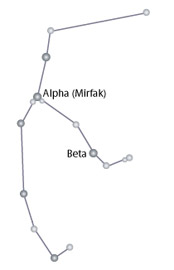Location: Northern Hemisphere
Coordinates:
Right Ascension: 03h
Declination: +45º
Source: Greek Mythology
The story behind the name: Perseus was the son of the Greek god Zeus and the mortal princess Danae. Perseus' grandfather, Acrisius, the king of Argos, was warned by an oracle that he would be killed by his grandson. Acrisius locked his daughter Danae in a dungeon to prevent her bearing a child. Zeus found a way into her dungeon disguised as a shower of gold.
When the child Perseus was born, King Acrisius locked Danae and Perseus in a wooden chest and threw it into the sea. The chest floated to the island of Seriphos, where it was rescued by a fisherman who was brother to the island's king, Polydectes. Polydectes offered them protection and Perseus was raised in his house. Polydectes may have had an ulterior motive as he later tried to force marriage on Danae. The king tried to mislead Perseus by saying that he intended to marry someone else. Perseus was so relieved that he promised the king a rather extravagant wedding gift, the head of Medusa.
Medusa was one of three sisters, daughters of Ceto and Phorcys, who was transformed into a hideous creature by the goddess Athene. She was angry at Medusa for having a liaison with Poseidon in one of her temples. Also known as the Gorgon, Medusa had serpents for hair, huge teeth, and a protruding tongue. One look turned people to stone. Athene helped Perseus gather magic equipment and gave him a shield to use as a mirror so that he would not look at Medusa directly. Perseus flew to the Gorgon's den with his winged sandals, and, using the shield as a mirror, cut off Medusa's head and buried it. The winged horse, Pegasus, and a warrior, Chrysaor, emerged fully grown out of Medusa's body, a product of her liaison with Poseidon. They, and her two sisters chased after Perseus, but he escaped.
Perseus had many adventures on the way back to Seriphos. He stopped at the palace of the Titan Atlas and was refused hospitality so he used the Gorgon's head to turn Atlas in to a mountain. He saw the beautiful Andromeda chained to a cliff to appease Poseidon's sea monster. He rescued her from the monster and married her, using Medusa's head to defeat an attack by her relatives. Perseus then saved his mother from marrying Polydectes by turning the king and his court to stone with the head of Medusa.
King Acrisius, however, could not escape his fate. There are several versions of how Acrisius and Perseus came to be in the same place at the same time, but in all of them, Acrisius is accidentally killed by a discus thrown by Perseus in funeral games. Although Perseus was placed in the sky near Andromdea, the constellation is usually depicted showing him holding Medusa's head, with the bright star Algol marking her eye.
Introduction to Constellations | Constellation Sources | Constellations Index
Objects observed by Chandra in Perseus:



